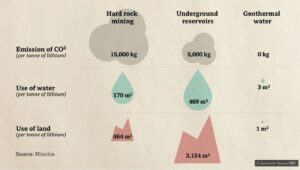

We were writing an article dispelling the myth that electric vehicles actually produce more environmental damage than traditional internal combustion engine (ICE) vehicles when we realized that the lithium story is too complex for a bullet point.


Like all scientific questions, the definitions matter but it is clear that Geothermal Lithium is an environmentalists dream. Hard rock and underground lithium have some nightmarish CO2, water and land implications but as you can see in the graphic below, sourced from the BBC, Geothermal Lithium production requires very little water, does not impact the land and emits virtually no CO2:
The concepts behind Geothermal lithium have been around since the early 2000’s and some initial commercialization attempts did not work out for a variety of reasons. However, like all technology, advancements have been made rapidly and in 2020 the lithium extraction has gone from 15 milligrams per liter to up to 200 milligrams of lithium per liter in the latest process from Germany’s Karlsruhe Institute of Technology (KIT). New geothermal lithium exploration in Cornwall (UK) have found concentrations as high as 260 milligrams per liter which will be commercialized within a few years.
Here is a detailed look at the process from end to end in a modern geothermal lithium plant built in Ontario, Canada for the Lanxess South Brine Processing Facility in El Dorado Arkansas:
The future is very bright for so called green lithium. The world is expected to consumer 20 times more lithium than it does today by the year 2040 and no-one wants the old open pit mines or evaporating ponds used widely today.
Here are some recent headlines about real companies making real investments into real green lithium:
“March 16, 2020 – LA Times
…On Monday, Lilac and the Australian company Controlled Thermal Resources announced they’re partnering to develop a lithium extraction facility at the Salton Sea (in California)… (The) Oakland start-up, Lilac Solutions, recently announced a $20-million funding round led by… Microsoft Corp. co-founder Gates, Amazon Chief Executive Jeff Bezos and former New York City Mayor Michael R. Bloomberg.” SOURCE
“May 12, 2020 – EGEC
…In Europe the race to optimise geothermal lithium took off with France and Germany leading the market. Geothermal lithium is at the heart of a European batteries value chain. A single project in France (Soultz Sous-Forêt) has an estimated annual production capacity of 1,500 tons of lithium carbonate: 10% of the French demand. Less than a dozen such plants would be able to cover the country’s entire current needs.” SOURCE
“Nov 24, 2020 – BBC
“…The brine in the Cornish mines has concentrations of up to 260 milligrams per litre, flowing at a rate of between 40-60 litres (8.1 to 13.7 gallons) per second. That works out as about enough lithium for a typical smartphone battery (2-3g) passing through the production process every few seconds, according to Cornish Lithium’s estimates… Cornish Lithium, a company set up by former investment banker Jeremy Wrathall in 2016, is working on plans to extract potentially significant lithium resources from the brine in the region’s famous mines near Redruth. …Zero carbon is also the goal for Cornish Lithium’s production process, which it envisions will be powered by geothermal heat. ” SOURCE
This website uses cookies.
View Comments